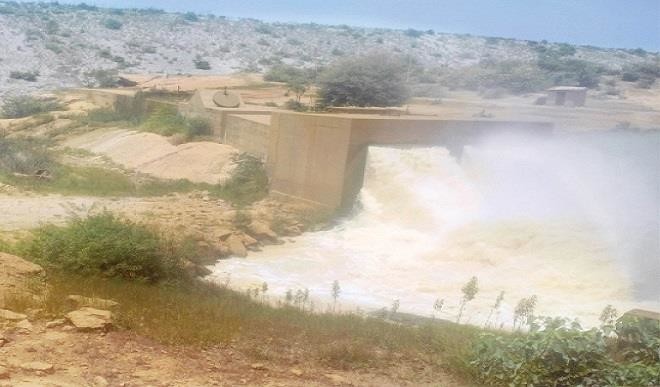
Unlike Tiga dam, which is being put into good irrigation use, its sister dam, the Challawa Gorge dam, is wasting away, according to its host communities. Both dams were initiated by a former governor of Kano State, Commissioner of Police Alhaji Audu Bako, in an attempt to improve food security of the nation and economic viability of the state through irrigation.
Improvement of water supply to Kano city, towns and settlements along the dams, as well as fisheries, livestock development and recreation are also other usage expected to benefit from the dams.
The Tiga dam was completed during Bako’s administration while the Challawa Gorge dam, started by the Kano State Water Resources and Engineering Construction Agency (WRECA) before it was handed over to the federal government which funded the project. It was built by Julius Berger between 1990 and 1992 and it’s being operated by a federal agency, the Hadejia-Jama’are River Basin Development Authority.
Although the Tiga dam has contributed immensely towards the food security of the country and economic prospects of the people around the dam through irrigation farming, the Challawa Gorge dam, which is bigger and has similar potentials of the irrigation and hydro-power generation, has not benefitted the host communities in that direction for over 20 years.
“Fishing and tourism are the two other potentials of the dam which are not being harnessed properly,” said Abdullahi Magaji, an indigene of Karaye, one of the local governments where the dam is located. The dam is also bordering Kiru and Rogo local government areas, respectively.
Magaji lamented that since the regime of Military Head of State Ibrahim Badamasi Babangida, which completed the project, all the subsequent governments, had pledged to harness the dam to its full potentials, except the immediate past government of former President Goodluck Jonathan.
Magaji added that: “For almost 25 years now, this dam has not been put to use as it should be. As a matter of fact, the failure to utilize the facility is only threatening the community that hosts the dam. While the communities wallow in poverty, water from the dam has to be released for operational purposes every year.”
Another resident of Karaye town, Mallam Muhammad Danbaba, said there was no better way to benefit from the potentials of the dam by the host communities than to use it for irrigation farming. He said the wisdom behind the two dams was to advance the economic activities of the state and farmers in communities around the dam were ready to cooperate with government to ensure successful execution of the idea behind the project.
“Looking at the economic activities taking place in communities where Tiga dam irrigation channel is serving, you will know that there is a potential for development in the areas. The dam is useful to the communities, people are engaged throughout the year and their economic condition has been improved,” Danbaba said.
Sunusi Yakubu, a welder in Kiru Local Government, who was at the dam to celebrate the just concluded Sallah festival, said the dam lacked recreational facilities for fun seekers. “This place should be a good relaxation centre but because of poor management people are avoiding the dam. As you can see people visiting the dam during festivities could only hang around,” he lamented.
Similarly, Sani Mai Giwa, the Chairman of Challawa Fishers Association, said fishing activities at the dam were facing peculiar challenges, but added that the fishermen are grateful that the business is still surviving.
He said: “We are using traditional method of fishing such as ‘koma’ (small hand net), ‘burgi’ (large fishing net) and so on. But in a contemporary setting, the fishing industry has changed, so we want to be assisted with new methods of fishing so that we can do the business in a modern way.”
Mai Giwa said releasing water from the dam for irrigation would not affect their business in anyway; rather it could even boost the sales, as the fishermen would sell the fish to other parts of the country once prospective buyers of vegetables and other farm produce know that irrigation was taking place.
“Our major concern as regard to fishing in the dam is the general disregard to the established law on how the business should be done. Some fishing methods banned by the law (such as tariya, taru, bugun ruwa, etc) which are serious threat to existence of fish in any water are common practice in the dam. So government has to come in and address some of these challenges,” he said.
Dr. Adnan Abdulhamid of the Geography Department, Bayero University Kano (BUK), said the dam could be used for irrigation farming by the host communities and beyond.
“Among the local councils hosting the dam, only Rogo Local Government, which is upstream, cannot benefit from its irrigation potentials,” Abdulhamid said, adding that “communities in Karaye, Kiru, Bebeji, Madobi and beyond could benefit from the dam’s irrigation potentials if there are proper arrangements towards achieving that.”
In 2009, a senator who is serving his third term as representative of the Kano South Senatorial District in the upper chamber, Senator Kabiru Ibrahim Gaya, started a 300-hectre irrigation scheme called Challawa Irrigation Project (CIP) through a constituency project in Karaye Local Government. The project, which has reached an advance stage, has been abandoned.
Also, the immediate past Governor of Kano State, Senator Rabi’u Musa Kwankwaso, started a hydro-power project at both the two major dams in the state. The project at the Challawa dam, according to a projection by the Kwankwaso administration would generate 25 megawatts of electricity and 10 megawatts would be generated from the Tiga dam.
Though Kwankwaso had good political zeal towards the project and because of his eagerness to actualize it, the former governor was convinced that the two dams could generate 35 megawatts of electricity, said a source who prepared to be anonymous.
The source said as a result of Kwankwaso’s enthusiasm to actualize his mission, some ministries critical to the success of the project, such as ministries of mines, power and that of water resources were not involved at the initial stage of the project. “At the moment, as all the crucial stakeholders have decided to join the project to safeguard the continued existence of the dams, it has been established that the two dams could only generate 13 megawatts of electricity; 6 megawatts from the Challawa dam while 7 megawatts from the Tiga dam,” the source said.
“Even if the Challawa dam could generate 25 megawatts of electricity as the Kwankwaso administration had projected, the water capacity in the dam could only generate that for only three months. After the period, then there will be no water in the dam, no electricity and of course, no irrigation which is the most significant,” the source added, explaining that “releasing the whole water in the dam within three months can also cause downstream flooding.”
According to a 2002 World Bank and Lake Chad Basin Commission study on Appraisal of the Safety of the Tiga and Challawa dams, downstream of the confluence at the Challawa dam, “the population at risk is tens of thousands.”
Salisu B. Hamzat is the Public Relations Officer, Hadejia-Jama’are River Basin Development Authority, he said the CIP started by Senator Gaya was not abandoned but funds had to be allocated for the project to continue. He said the project was first awarded to an Indian contractor and later the contract was revoked and re-awarded to an indigenous company.
In anticipation of successful achievement of the project, Hamzat said the agency had created a project office and appointed a manager who would manage the scheme after the completion.
He said: “Fishing and recreation are not part of our mandates. They belong to federal ministry of agriculture and that of culture and tourism. The Hadejia Jam’are is mandated to provide surface and underground water for irrigation and domestic purposes and the agency is using water being released from the Challawa dam to enhance greater Kano water supply and Hadejia Valley Irrigation Project.”
The storage capacity of the Challawa dam, according Goes’s 2002 study published in River Research and Applications, is 972 M m3 (million cubic meters). This means that there is abundance of water in the dam, which is not available to the host communities.

 Join Daily Trust WhatsApp Community For Quick Access To News and Happenings Around You.
Join Daily Trust WhatsApp Community For Quick Access To News and Happenings Around You.


